Bull
Breeding Soundness Examination
 pp222-235 pp222-235
The Bull BSE form
copyright from the Society for
Theriogenology
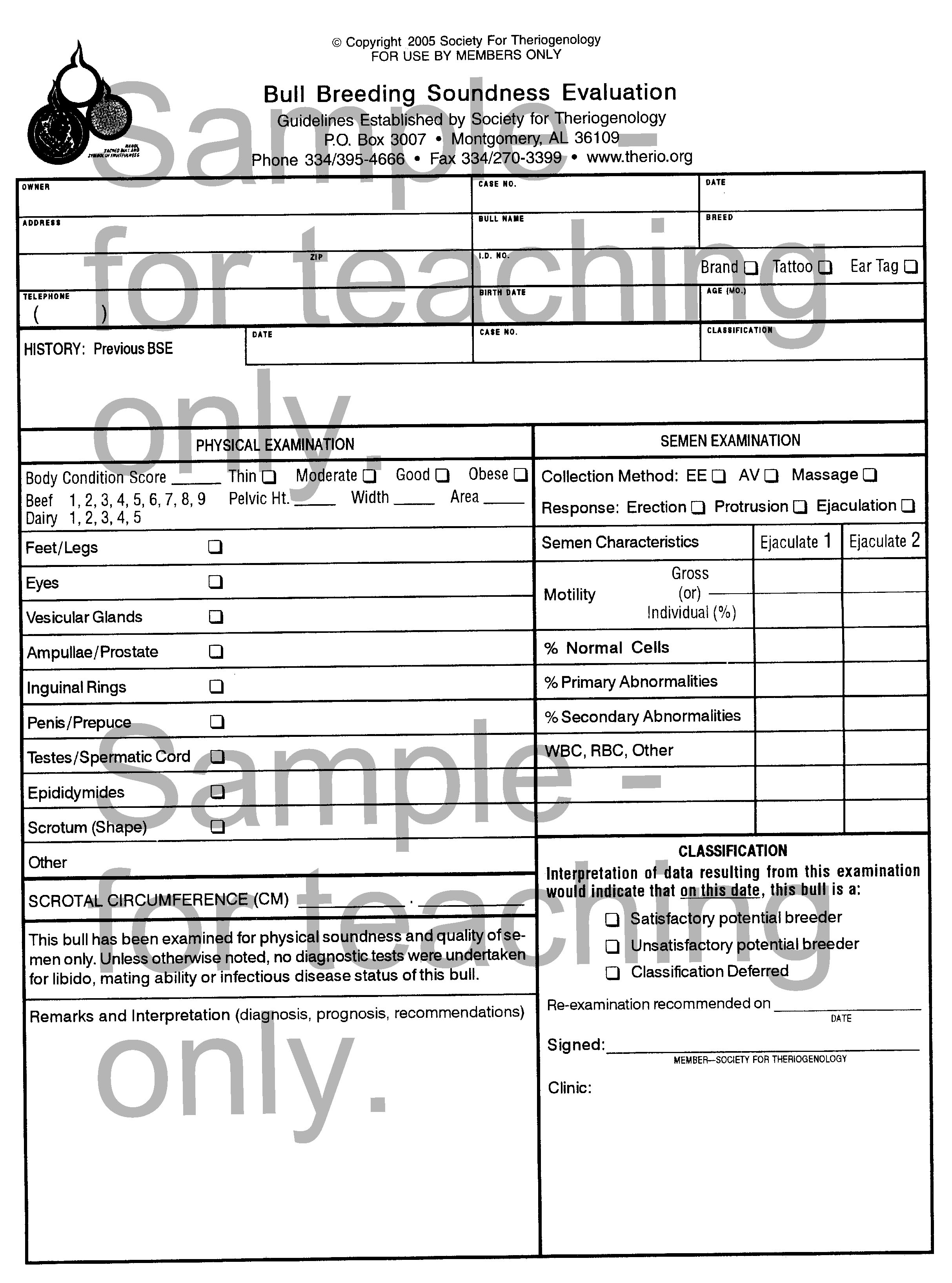
Click to enlarge sample
- The first question we should ask is 'Why do a
bull BSE?'
- Economically, it has been shown to pay a $17.00/cow
(1970s dollars) return on the BSE the investment of bull BSE.
- That
is $17/cow, not per bull.
- If you figure that a bull is usually
exposed to about 30 cows.....do the math.
- When do you want to do a bull BSE?
- A bull BSE
should be performed before purchasing a bull, if fertility problems
are a concern, or 30 -60 days prebreeding.
- If you use the SFT BSE form you have more
legal history behind you than the system you 'invent'.
History
- In most cases we must rely in the producer's
observation for libido, mating ability, and social dominance. If the
bull will not find cows in heat, will not mate or is dominated by
other bulls, then even if he passes a BSE it matters not. Performing
libido testing and mating ability is a difficult and time-consuming
task, so it is usually not incorporated into most routine bull BSEs.
Physical examination
- Identification of the bull is essential.
Obviously a hide brand, or ear tattoo is better than ear tags for
positive identification. If you have a controversial case, take a
photograph.
- A physical exam is important in determining if
a bull will be able to adequately breed. A bull's body condition
must be good at the BSE, because a bull will lose condition during
the breeding season. If he starts too thin, he may not be in good
enough condition later on to breed cows.
- The bull's locomotion system must be good as he
needs to get to cows to breed them. Poor conformation can contribute
to lameness, which obviously contribute to breeding problems.
- Test the bull's vision, as bulls identify
estrual cows by sight, not by smell. If a bull cannot see, he will
not find the cows in estrus.
- Look at the teeth. A bull needs to eat in order
to stay fit enough to breed. You can also age a bull by his teeth.
- Look carefully at the sheath for its
conformation. It should basically point at the ground between the
bulls front feet (except for the last bit on the tip). Check it
carefully for an abscess, eversion, or prolapse. If these conditions
appear during a BSE, the bull will probably not last the breeding
season.
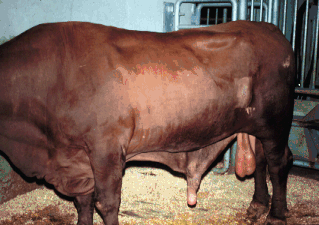 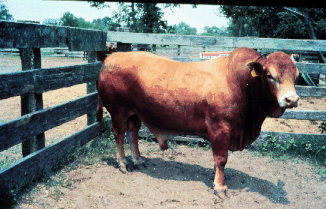 Poor
preputial conformation (left) and good conformation (right).
Libido testing Poor
preputial conformation (left) and good conformation (right).
Libido testing
- Libido testing is not routinely performed when
doing a BSE.
- The 'one bull method' has a restrained heifer
and you allow the bull 10-15 minutes to mount the heifer. A bull
should mount at least once. If he does not mount, he should fail and
be tried again.
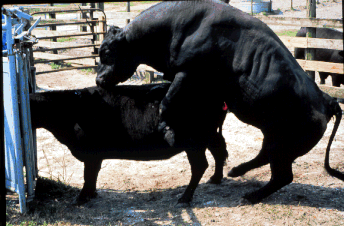
- The 'multiple bull method' used 4 heifers on a
pen perimeter, with 5 bulls turned in with them. Each bull should
serve at least 3 times in 40 min. As they breed you can remove those
that do breed to allow the others more chances to breed without any
bull dominance affecting the breeding performance.
Penis
- When the bull is being ejaculated, make sure he
can fully extend his penis. Phimosis is when the bull cannot get the
penis out, and paraphimosis is when the bull cannot get the penis
in.
- During ejaculation check for a persistent
frenulum. This occurs when the prepuce remains attached to the glans
penis. It may be a heritable condition, so it is best not to keep
bulls that have it.
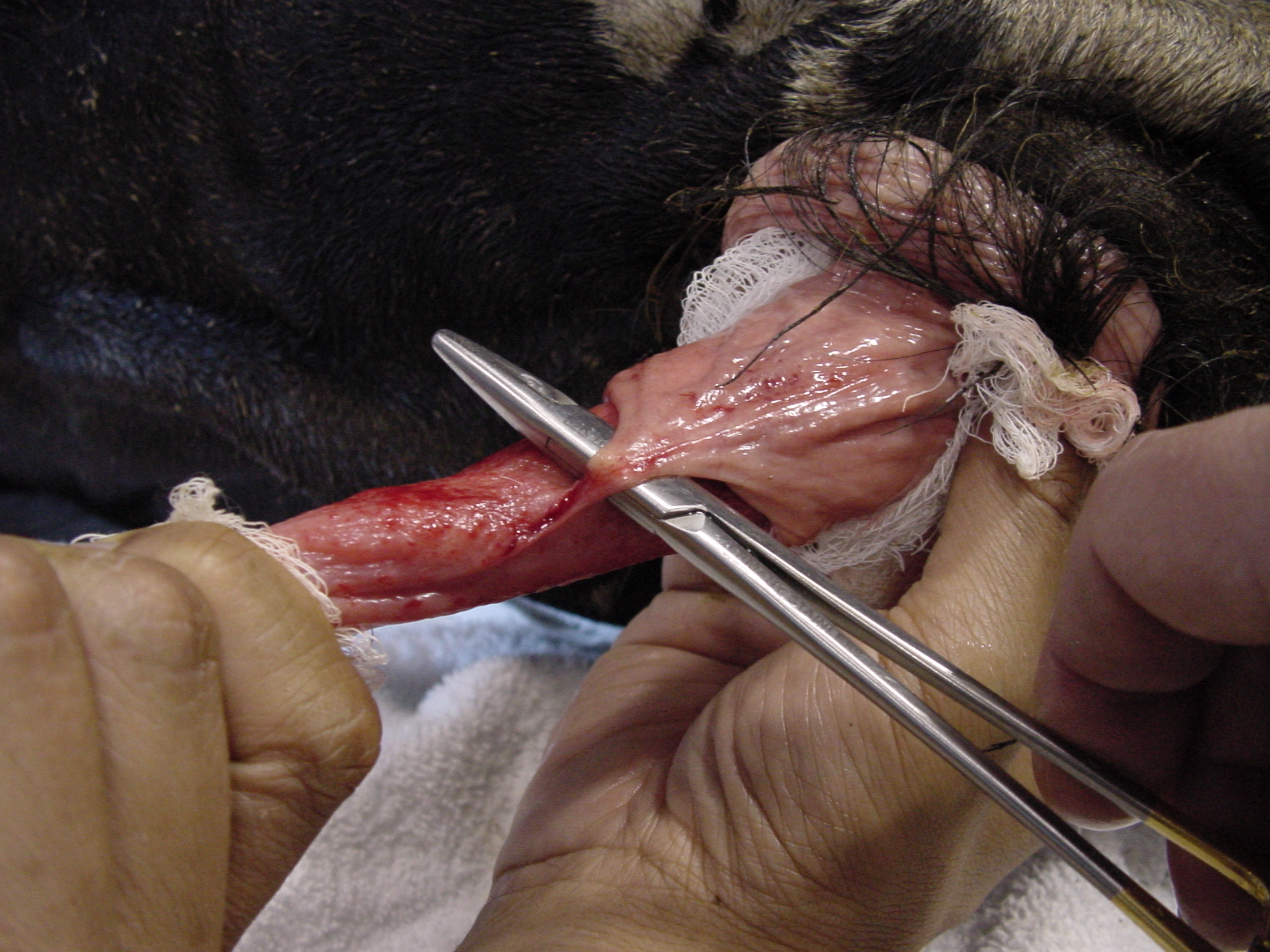
- An adequate length for a bull's penis is that
it should come almost between the front legs during a full erection
and extension. A bull with a too short penis will not be able to
breed.
- Other penile problems such as deviations of
corkscrew, rainbow, or lateral deviations should be noted and will
cause a bull to fail a BSE.
- A fibropapilloma on the bull's penis may cause
hemorrhage during breeding, and result in infertility.
Testes
- The testes should be examined for carriage,
consistency and size.
- The shape of the scrotum is important for
thermoregulation of the testes. A 'neck' should be present in the
scrotum, but abnormal shapes include scrotums that are pointed or
straight sided.
- The testes should be freely moveable within the
scrotum and the testes should be symmetric. The testes may rotate 40
degrees normally and the 'scrotal ligament' may cause the testes to
be pulled dorsal and caudal, but this has little apparent affect on
fertility.
- Any testicular asymmetry is abnormal and may
indicate orchitis, testicular degeneration, hydrocele, or hernia.
The testes should have the consistency of a flexed biceps muscle.
- The size of the testes is correlated with sperm
production in the bull and age of puberty in the offspring.
- It is also important to palpate the epididymis
to ensure that it is present and it is normal.
- Scrotal circumference is an indirect measure of
testicular mass, it is associated with sperm production, and it is
associated with parenchymal health of the testicular tissues. Bulls
with small testes produce less sperm, have a later puberty in their
daughters and
sons and have earlier testicular degeneration.
- The scrotal circumference is measured at the
widest point of the scrotum, being careful to pull the testes down
into the scrotum and to keep the testes together. Errors can be made
if fat is in the scrotum, a hernia is present, hydrocele is present
or the testes are pushed apart when the measurement is made.
 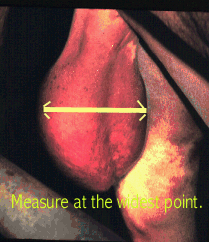
Internal accessory glands
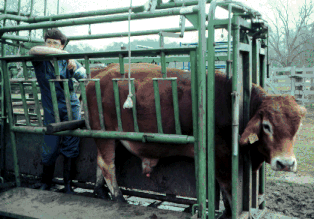
Bull palpation
- The prostate is palpated as a band that crosses
the pelvic urethra.
- There are no diseases associated with the
prostate, but it is a useful landmark.
- The ampullae is the distal portion of the
ductus deferens that connect to the pelvic urethra. There are
generally no problems with this accessory sex gland.
- The seminal vesicles are paired glands that
feel like a bag of grapes on either side of the pelvic urethra. Seminal vesiculitis is a fairly common disease of bulls. Any asymmetry or
pain associated with palpation is an indication that vesiculitis may
be present.
- The inguinal rings should be palpated. They are
normally about a hand's width off the midline and a hand's length over
the brim of the pelvis. You can usually just get your fingers into
the rings. If the rings are large, or a loop of intestines is going
through the rings, the bull may have problems in the future.
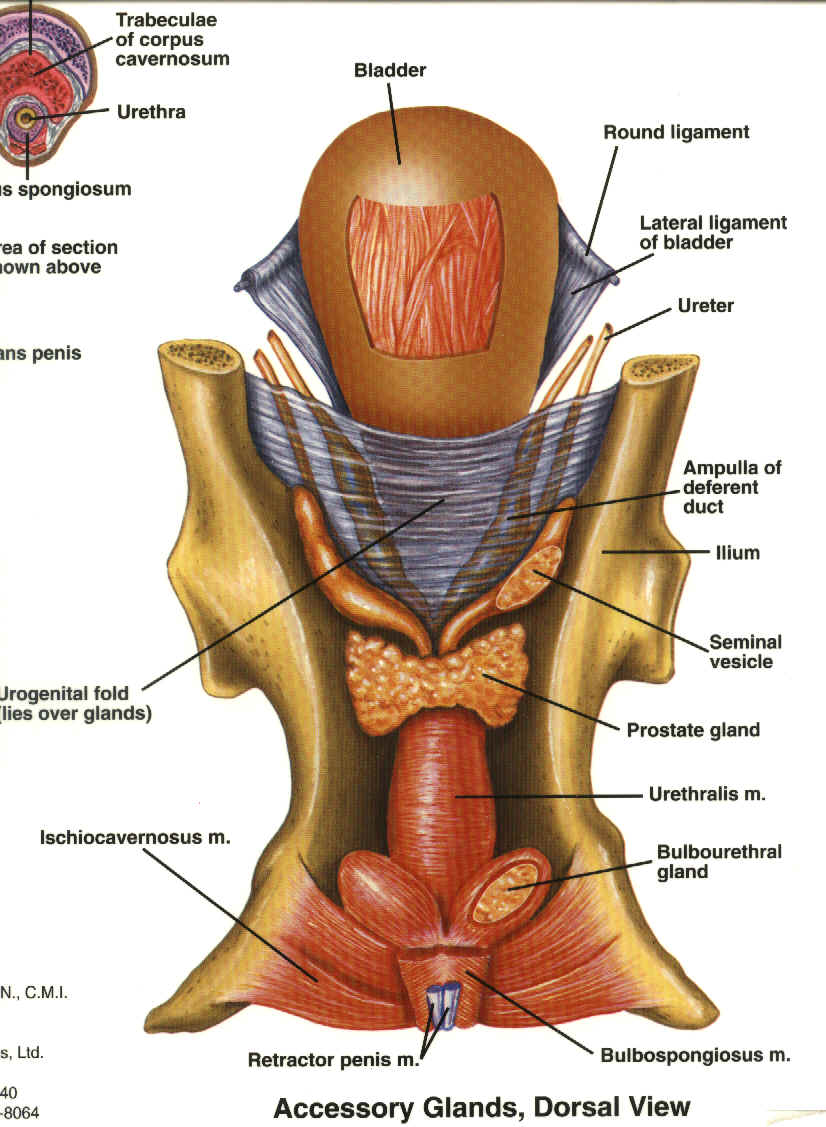
Stallion - Bull is similar
Semen collection
- An artificial vagina (AV ) is the ideal method
to get a physiologic semen sample. Unfortunately this can only be
used on trained bulls.
- The electroejaculator is the most commonly used
method to obtain a semen sample.
- The mild electrical stimulation
stimulates sympathetic and parasympathetic nerves to cause
ejaculation, however it is not a physiologic sample that is
collected.
- The electrodes should face ventral
- You can dilute sample by excess collection of vesicular
fluid.
- Some bulls do not respond well and some bulls go down
(Brahman) with the stimulation.
- The technique is one of a gradual
build-up of electrical stimulation until the bull has an erection,
protrusion of the penis and ejaculation.
- Some machines are manually
operated and some are preprogrammed to deliver the correct stimuli.
- You start with a low 'power' setting
and then work the 'power' up until erection, protrusion and
ejaculation.
-
In cold
climates the
collection
cup ('loving
cup') is
insulated
with a warm
water
jacket.
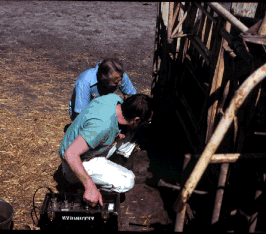
Semen Collection using an electroejaculator.
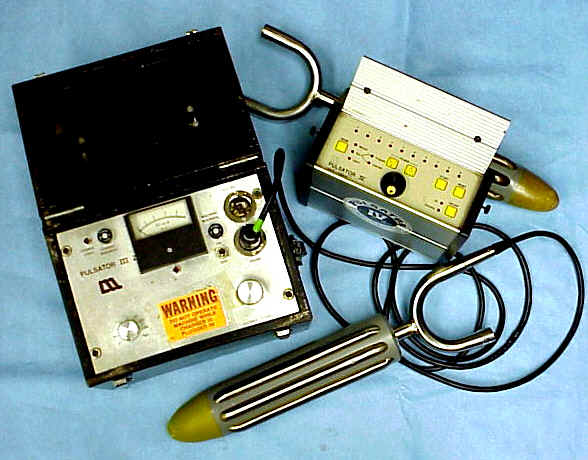
Electroejaculators. On the on the right an 'automatic'
machine.
- Manual massage of the prostate, ampullae and
seminal vesicles can also produce an ejaculate.
- This is a good alternative for bulls that go
down on electroejaculation.
- You can massage the seminal vesicles to
produce an erection and the ampullae to produce ejaculation.
- This is
not possible in all bulls however.
-
Is it painful?
-
Vocalization has
been deemed to
be an indicator
of pain, so
apply electrical
stimulation as
carefully as
possible
-
Local anesthesia
has not shown to
be effective at
eliminating
vocalization
-
Why do we use
it?
  Semen
Evaluation Semen
Evaluation 
Evaluation system for BSE:
- The following criteria are used to standardize
BSE among veterinarians in North America and to provide a more
legally acceptable set of standards to compare bulls.
- In order to pass a BSE a bull must have a
normal physical examination must meet minimum requirements for
scrotal circumference, sperm motility and sperm morphology. These
criteria are relatively easy to test and are easily repeatable.
- A bull must have >
30% individual motility to pass.
Motility is the most lenient criteria, as it can be influenced by
semen handling to a great extent.
- The sperm cell morphology must have
> 70% normal to pass.
- The scrotal
circumference must meet minimum criteria
for individual ages.
- A bull must meet these minimum criteria in
each category to pass a BSE.
- The final classification can be:
- Satisfactory - the bull passed all 3 criteria
and should be a good bull.
- Deferred - the bull did not pass all criteria,
but should be reevaluated, because you feel the problem may resolve
over time.
- Unsatisfactory - the bull does not pass all
criteria and has non-resolvable problem.
- The examiner holds the final diagnosis and may
fail a bull for any valid reason. Any problem can fail bull.
- do a complete physical
What a BSE is not !!!!
- It is not indicative of relative fertility. It cannot
rate a single bull better or worse than another individual. It is
designed to identify groups of bulls that are more or less fertile
than other groups of bulls.
- No libido testing is generally done.
- Mating ability is not determined.
- Venereal diseases are usually not checked,
because a single negative sample is meaningless.
Other available
fertility evaluators
Fertility Associated Antigens
- Presence allows increased acrosome reaction
- More fertility from bulls that have it
- Do non fertile bulls have it?
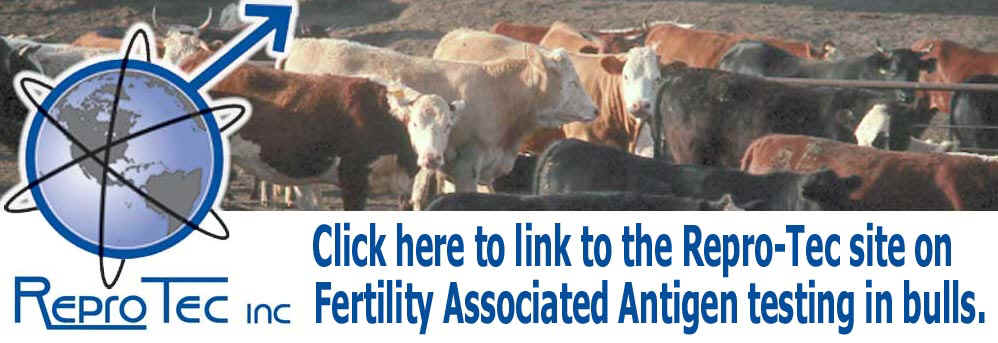
Bull Infertility
Congenital infertility
Testicular hypoplasia
- The sperm cells fade at the primary
spermatogonium stage. It is seen in Swedish red and white bulls.
- Segmental aplasia of the epididymis. The
epididymis is absent, so cells cannot get from the testes to the
penis.
Short penis
- This is a heritable and can cause infertility
because of the difficulty the bull has breeding.
- A bull should be able to almost extend the
penis between the front legs.
Persistent
penile frenulum
- The frenulum usually separates by 32 weeks.
- The band on ventral aspect from the penis to
the prepuce persists.
- The ligament can be cut and ligated, but it is
recommend against breeding these animals.

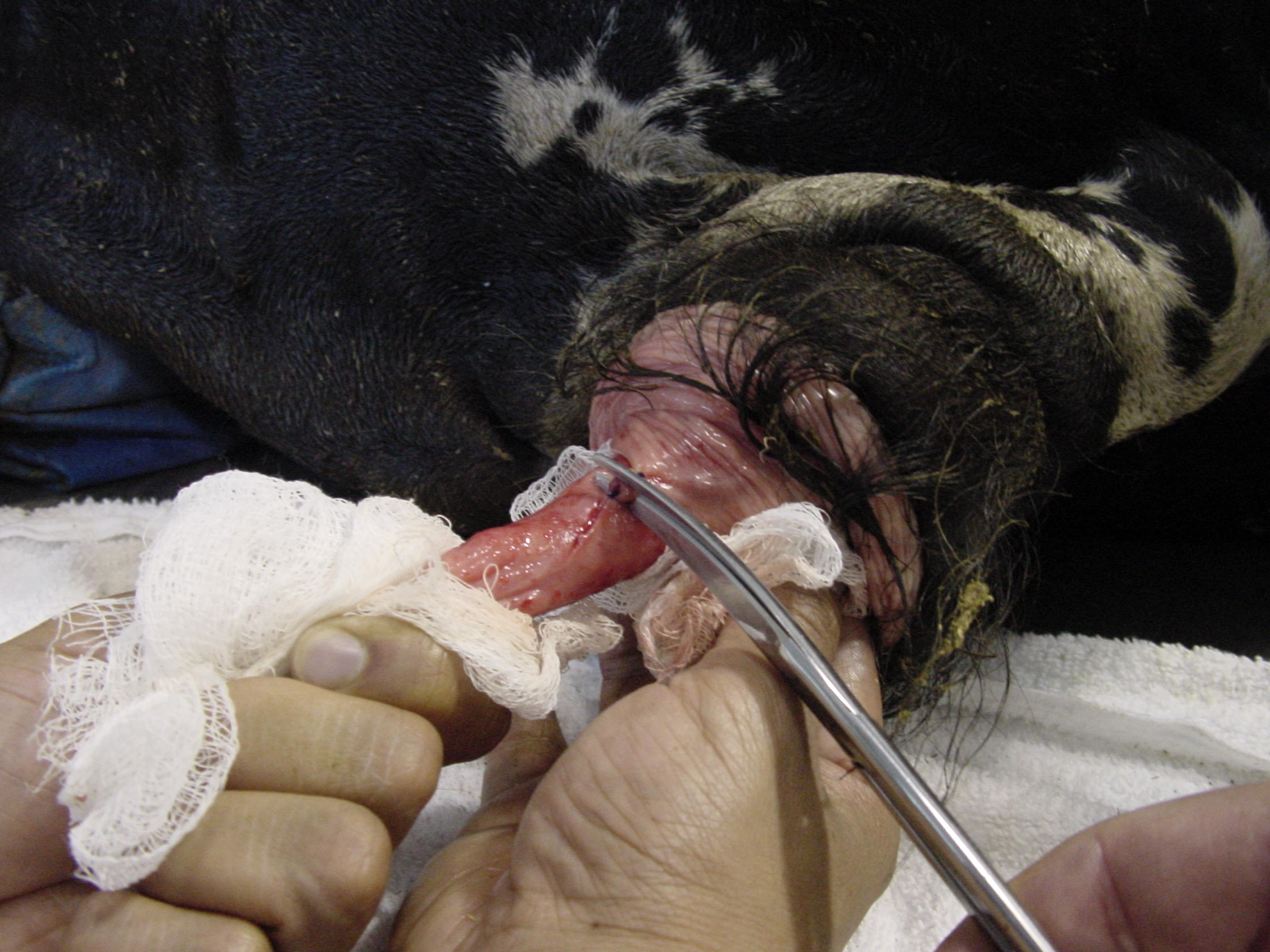
Short retractor penis
- The short retractor penis prevents penile
extension.
- Diagnosis is by feeling a tight band at
erection where the retractor penis muscle is.
- A short unilateral retractor penis results in a
bulge unilaterally by the scrotum on erection.
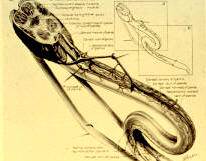
Penile deviations
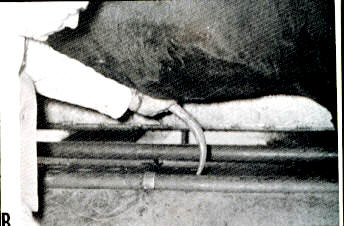
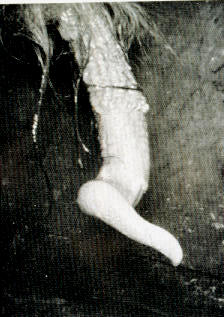
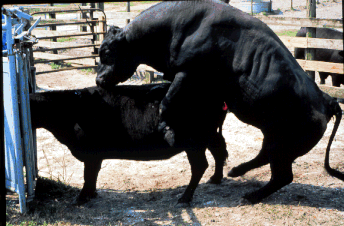
A corkscrew or lateral deviation
at breeding.
- You cannot diagnose a corkscrew penis when
electroejaculating a bull.
Acquired diseases
Seminal vesiculitis
- The clinical signs are pus in semen, painful
vesicular glands, enlarged glands, and firm glands.
- The cause may be a congenital and inherited
problem in the colliculus. This allows ascending infections access
to the seminal vesicles.
- It may be seen in young, grouped bulls.
- Actinomyces pyogenes is the most common isolate
in individual cases, but
- Brucella, E. coli, Pseudomonas, Strep, virus,
mycoplasms, ureaplasms have been isolated.
- Diagnosis is made by seeing pus in the semen,
enlarged glands, and possibly by culture of the vesicular fluid.
Culture should be done by placing a catheter up to the seminal
vesicles and collecting pure vesicular fluid. Semen cultured at
ejaculation may always contain contaminants.
- There is little effective treatment,
particularly in older bulls.
- The disease usually becomes chronic and
treatment by antibiotics is usually not successful.
- Surgery, removal of the seminal vesicles may be
tried as a last resort, but success is not likely.
- These bulls should probably be culled as the
condition may be hereditary.
Testicular degeneration
- In testicular degeneration the testes were once
normal, but now the germinal epithelium is gone.
- The testes have a very limited response to any
injury. Meiotic cells (prim. spermatocytes) are affected the most.
The spindle formation is disturbed and results in major damage.
Mitotic cells are less affected (the A,and B spermatogonium).
- With a mild injury the cells divide, but the
nuclei are unequal, so you get head abnormalities. You see poor
motility and proximal drops.
- With moderate injury you see premetaphase
damage, so the spindle is disrupted earlier and the result is chromosome
lysis. You see few cells, poor motility, proximal drops,
and nuclear craters.
- With severe injury there is metaphase
interruption and the chromosomes condense, with the result being
- Giant cell results, and 'restitution' cells. In
these cells the chromosomes divide, but the cell does not. This
results in a chromatin rich cell and indicates that the point of no
return has been reached.
- The diagnosis is made by a history of once
being normal and now having few to no sperm cells.
- The cells seen in the ejaculate are indicative
of degeneration and include restitution cells and giant cells.
- A biopsy reveals a thickened Basement Membrane,
and only Sertoli cells.
- Reexamine in 60 days
- Hypoplasia predisposes
- Decreased gonadotrophins
- Orchitis, periorchitis
- Causes of degeneration include:
- Strain 19
vaccine,
- fever,
- autoimmune,
- chemicals,
- Cadmium,
- fluorinated
napthalenes,
- griseofulvin,
- EtBr,
- toxemias,
- high Estrogen,
- exogenous
Estrogen,
- Testosterone,
- aging,
- twinning (freemartin),
- chromosome
abnormalities,
- pampiniform phlebitis,
- frostbite on the scrotum,
-
environment (heat stress),
- inguinal hernias,
- scrotal fat, trauma,
-
tumors,
- testicular biopsy,
- stress, starvation,
- radiation
- laying
down excessively (this increases scrotal temperature).
Treatment
- To treat degeneration you must first remove the
problem.
- Cool water hydrotherapy and sexual rest are
also indicated.
- NSAIDs are also indicated.
- You should recheck the bull in 60 days, after a
complete cycle has been completed.
Testicular ultrasound
- The parenchyma has a homogeneous ground glass
appearance. The mediastinum testis is an echogenic line in the
center of the testes.
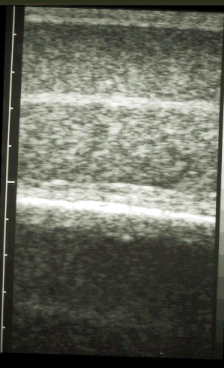
- The tunics are seen as an echogenic line
closely applied to the testes. You only see one unless there is a
hydrocele, which will be seen as a fluid density (black) between the
tunics.
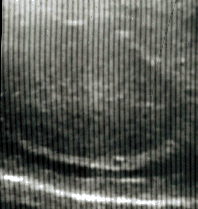
- The epididymis has a 'moth eaten' appearance.
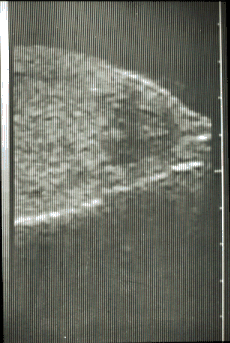
- Fibrotic foci do not adversely affect breeding
soundness.
|






 Male
Index
Male
Index













